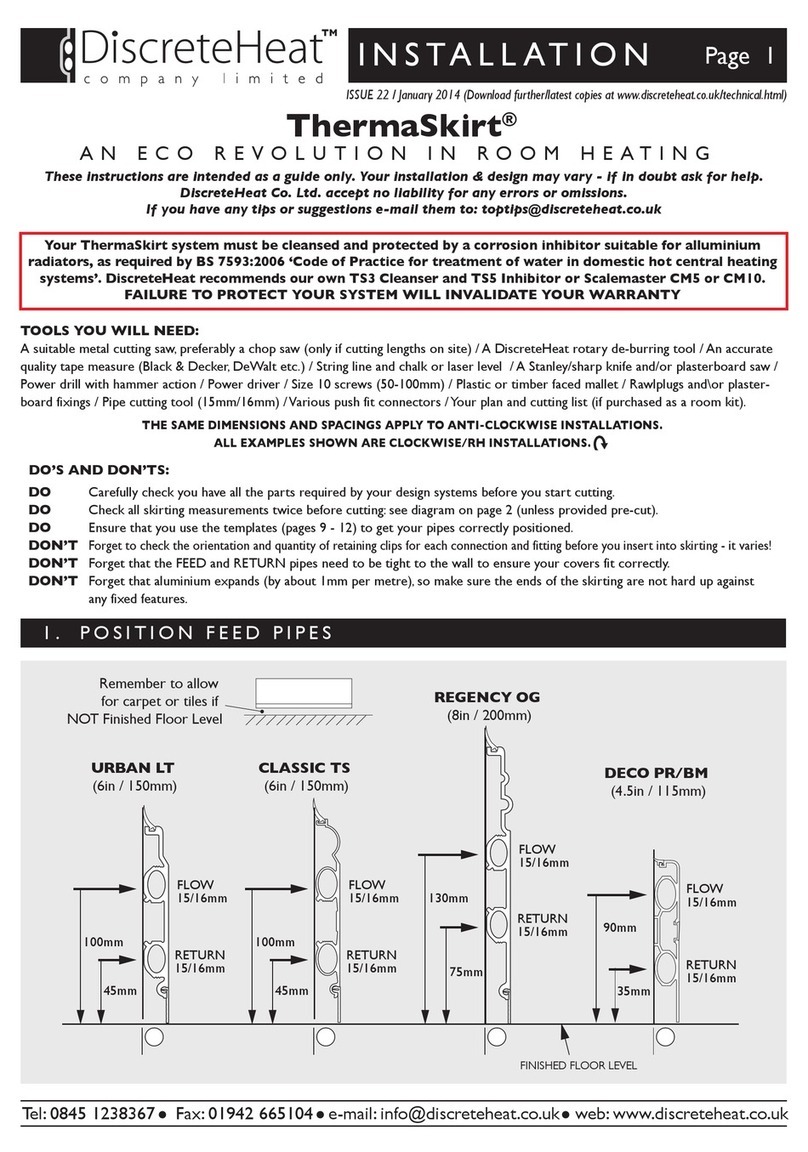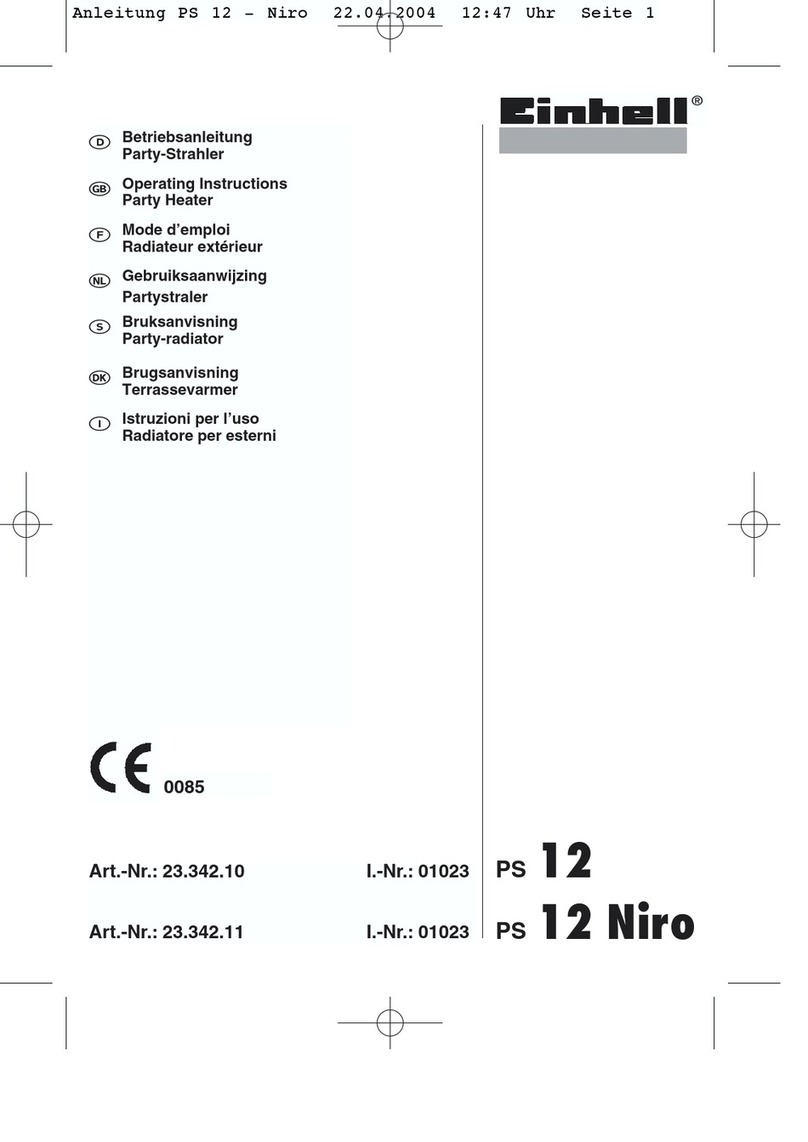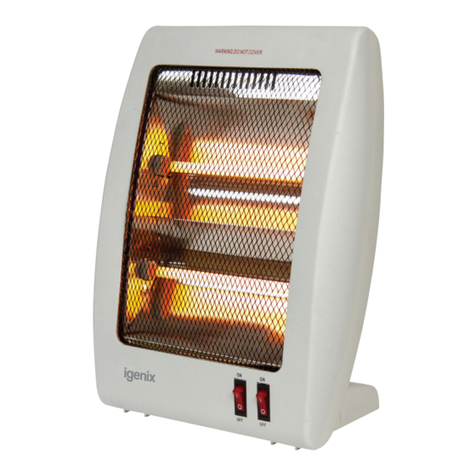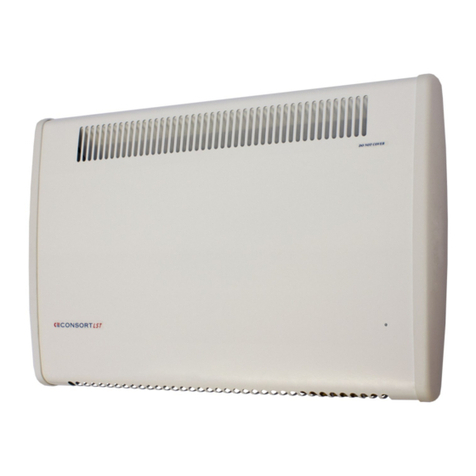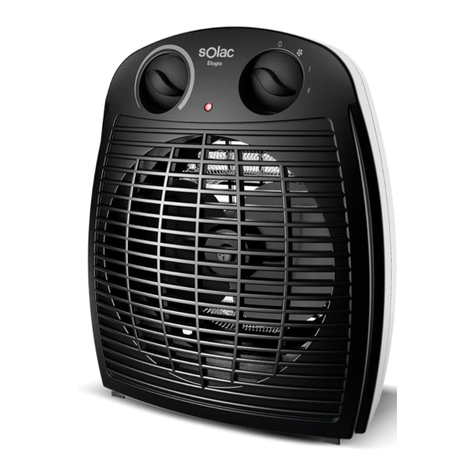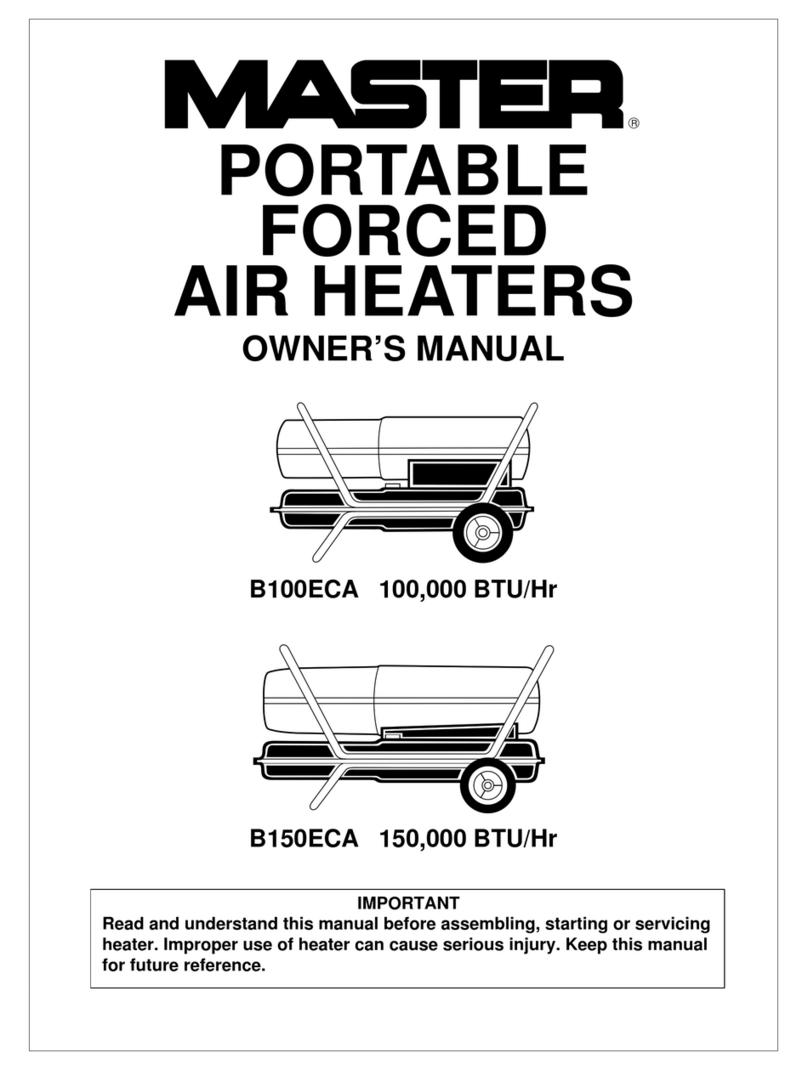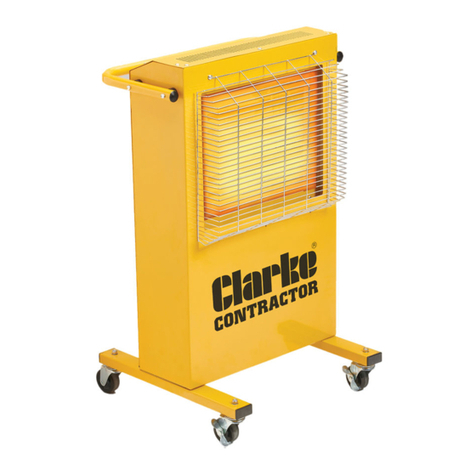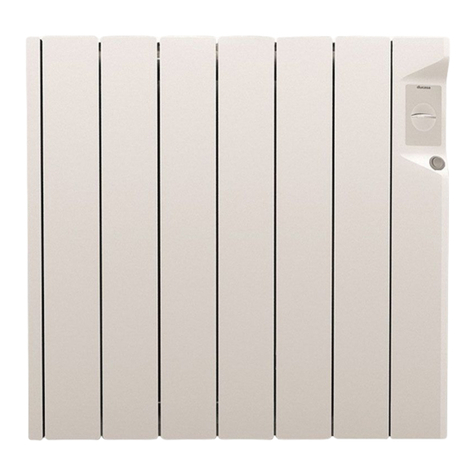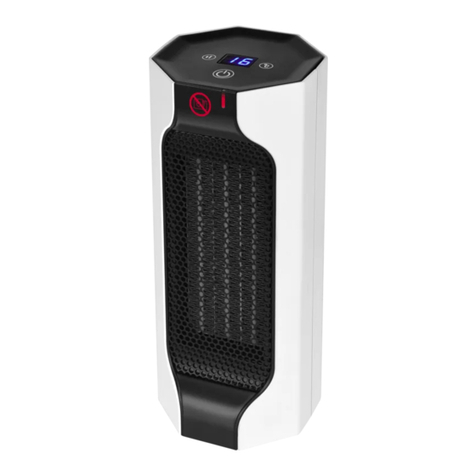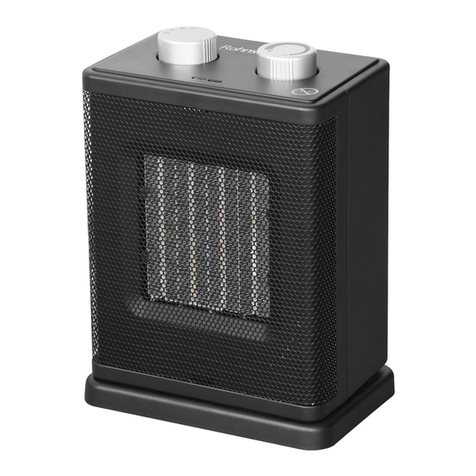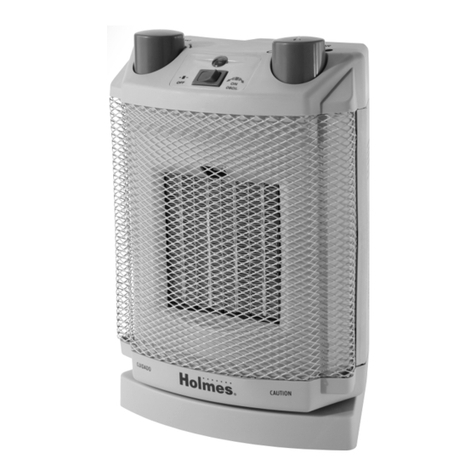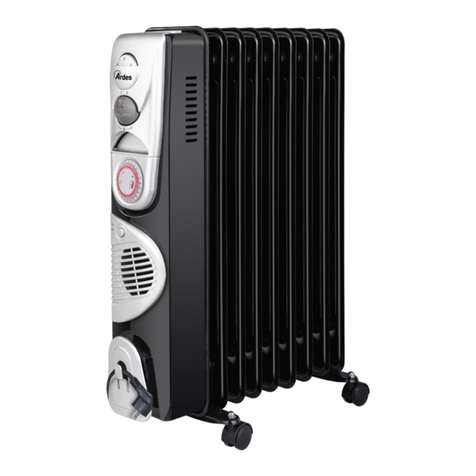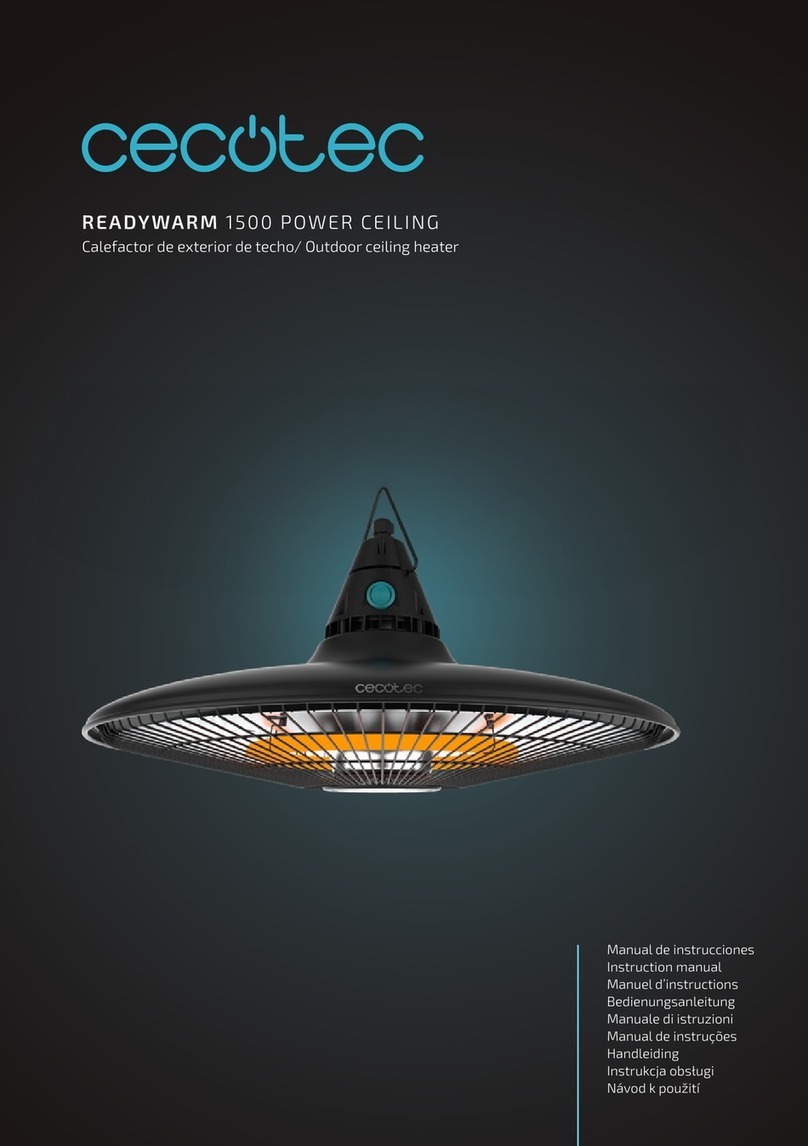DiscreteHeat ThermaCurve User manual


05



05
Installing the Power Connection PCB
Bracket
1. Mount the ‘Easy Bend’ PCB bracket
approx. 25mm (1”) from the corner
of the wall/start of run, and up to the
ceiling. Do not over-tighten the 2
mounting screws so the bracket can
still slide on the slots. For mid-wall
installation, see separate instructions
provided.
2. When secure. Bend the bottom edge
up at 45° to form the angled bracket.
3. Installing the 1st Wall & Ceiling
Brackets.
4. The Wall bracket is fixed using the
centre slot (with teeth) and the oval
washer. Check its secured.
5. The ceiling bracket is secured (but
slides) using the lower slot (no teeth)
and the round washer. Check bracket
still slides.
6. 2nd & 3rd Brackets.
The 2nd set of brackets is fitted in the
middle wall length. The 3rd set is fitted
~200mm from the end/ corner of the
wall.
Middle of wall
200 mm
250 mm
~225mm/9”
~200mm/8”
~250mm/10”
Bend here 90
~25mm/1”
Bed up to 45
Oval Washer
Wall Bracket
Fixed
Round Washer
Slides

06
Preparing the ThermaCurve Prole
When cutting the ThermaCurve profile, the following allowances should be made:
Power Connection
/ PCB Internal Corner External corner Special Angle End Termination
Wall length
MINUS
200mm/8’’
Wall length
MINUS
125mm/5’’
Wall length
MINUS
25mm/1’’
Wall length
MINUS
150mm/6’’
Wall length
MINUS
100mm/4’’
1. When cutting the ThermaCurve
profile, remove any back capping
to prevent swarf or chips becoming
trapped, which could damage the
heating cable when inserted.
2. Using a pair of long nose pliers or
similar, ‘splay out’ the cable channel at
the ends to create a wider, ‘bell mouth’
opening. This prevents the heating
cable from snagging.
3. De burr! Using the rotary de burring
tool (from the spares kit) chamfer the
cut ends. Note; failure to follow 8.2 & 8.3
may invalidate your warranty.
200mm
125mm
25mm
100mm
150mm
Wall
ThermaCurve Prole
Wall Length L
Wall Length CL
Prole Length PL
Clockwise System
1
2 3
4
5
6
Start Connection
Termination
End of Run
Cable Connectors
PCB/ Start
Prole
Cable Connectors

07
Preparing the cable lengths (if not
supplied factory cut)
Power Connection /
PCB Internal Corner External corner Special Angle End Termination
Wall length
MINUS
-100mm/4’’
Wall length
MINUS
-25mm/1’’
Wall length
PLUS
+25mm/1’’
Wall length
MINUS
-25mm/1’’
Wall length
MINUS
-50mm/’’
Or: Profile Length
PLUS
+100mm/4’’
Or: Profile Length
PLUS
+100mm/4’’
Or: Profile Length
PLUS
+50mm/2’’
Or: Profile Length
PLUS
+125mm/5’’
Or: Profile Length
PLUS
+50mm/2’’
Note: Heating cables are usually supplied pre-prepared. If not, prepare the cable ends before inserting into the
ThermaCurve profile; the cable is difficult to strip and mistakes are hard to correct once the cable is in the cable channels.
Preparing the Power Connection Cable
end
1. Remove the outer red silicone jacket
to reveal approximately 80mm (3 ¼”) of
black inner core.
2. Split the black inner core down the
middle and separate.
3. Using a Stanley knife (box cutter)
or similar at a shallow angle, slice
away the black core to reveal the inner
conductors; NOTE; safety gloves and
eye shields should be worn and always
cut away from yourself.
80mm
25mm
100mm
100mm
50mm
125mm
125mm
50mm

08
Preparing the Power Connection Cable
end
3. Apply some RTV silicone glue/sealant
and slide the silicone ‘trousers’ over the
conducting cores. Secure the trousers
to the outer silicone jacket.
4. Using an air heat gun, heat shrink
the trousers to the cable to create a
permanent joint.
25mm 30mm
100-120mm

09
Install the heating cables – First section
1. Lay the 1st ThermaCurve profile
face down (on a soft, clean surface to
prevent paint damage).
2. Insert the heating cables such that
the trouser PCB connection end is
protruding 100mm from the end. Secure
the cables into the cable channel using
the clear polycarbonate back capping.
3. Insert the heating cable into the
channel, and secure in place using the
clear back capping. The last section of
back capping can be cut to length.
Preparing the cable ends – Terminating
a single straight length (For onward
section see 12)
4. If the ThermaCurve is heating a single straight wall (no
corners or onward connections) then simply cut any excess
cable 50mm(2”) longer than the profile (50mm/2” shorter
than the wall).
5. Using the silicone ‘boots’, RTV/silicone sealant and the
heat shrink tubing, make safe the end of the cable.
100mm
Back Capping
50mm
Heat Shrink tubing

10
Preparing the cable ends – Making a
corner or onward connection
1. For an Internal Corner, the cable should be prepared as per
the Power connection 9.1 – 100mm longer than the cut prole
length (25mm/1” shorter than the wall length).
2. For an External corner, the cable should be prepared as per
the Power Connection 9.1, but 25mm/1” longer than the wall
(50mm longer than the cut prole).
Installing the Insulation panels
4. The insulation panels are supplied in
1500 x 100mm sections. They can be
cut to size using a Stanley knife or sharp
blade. The last piece should be cut to
within 50mm of the end of the section.
5. Once cut, they are secured in place
using the insulation clips as shown.
3. Protective gloves are recommended
when handling the insulation panels,
due to the nature of the material, which
can cause skin irritation.
50mm
100mm
50mm
Insulation Panel

11
Installing the 1st piece
2. At the power connection end, DON’T
forget to attach the EARTH lead into the
lower/wall earth way using the 6mm
self-tapping screw and serrated washer.
(Make sure the cable is facing towards
the wall to ensure the cover can be
fitted later).
3. Insert the security pins into the lower/
wall hinge point. There should be 3;
One for each of the end and middle wall
brackets. Note the security pins can
also be ‘squeezed’ into the wall side
hinge point groove.
4. In the ceiling/upper side hinge point
of the profile, insert the 8mm barrel nut
to a depth of approximately 50mm/2”
and loosely tighten the grub screw.
This forms the expansion stop against
the ceiling bracket and prevents cable
connection damage.
1. In the 2 wall brackets at either end
of the run, insert the 100mm/4” safety
cable line into the safety cable groove
and secure with the 2 x 5mm Roll pins.
5. Using a hop up platform or ladder if
required, raise the power connection
end to the wall brackets. Insert the
safety cable into the unused upper/
ceiling Earth way, and retain with 1 x
5mm roll pin.
6. Leaving the power connection end
hanging, move to the other end and
repeat.
Power Connection
End
Safety Cables
Earth Lead
Security Pins
Barrel Nut
12

12
Installing the 1st piece
1. With both ends suspended, move to the middle and raise the profile to the wall bracket. Locate onto hinge point. A firm
push may be required
2. With the bottom hinge point secure,
close up the profile to the ceiling
bracket. Ensure the top hinge feature
of the profile engages with the hinge
point of the bracket. Again, a firm push
may be required. If correctly installed,
the ceiling bracket will slide backwards
around 5mm, and the profile will lock
securely to the bracket. NOTE: Slide the
Security pins using a pick tool or prong
until it slides into the hinge groove of
both the wall and the ceiling bracket.
3. Move to the PCB connection end. The
profile should be close to the ceiling
bracket. Ensure there is good alignment
of the hinge point and profile and push
firmly home. Push home the Security
Pins into the wall and ceiling brackets.
4. Repeat for far end. Push home
the Security Pin. The 1st section is
now secure and ready for electrical
connection at the PCB end.
Power Connection
End
‘Click’
‘Click’
Security Pins
Security Pins
End Termination

13
Connecting the Heating Cables & Earth
1. If cut and secured correctly the Trouser ends of the cable
should be well located to reach the terminal blocks on the
PCB. Adjust if necessary, by sliding the Easy bend bracket or
alternatively carefully trim the trouser ends.
2. Connect the cables to the terminal. Do not over tighten to
prevent damage to the terminal blocks.
3. EARTH CONNECTION! For the safety of yourself and
others and the protection of the system, the earth lead must
be connected as shown.
4. DO NOT fit the PCB cover and end covers until after the
system has been connected and tested.
Terminal Block
Earth Lead
Adjust if necessary

14
Fitting the Next Section(s) (if a single
length only, skip to 16)
1. Using the same sequence as the first piece, install the
second section onto the wall and ceiling brackets, using the
clearances a shown in table 1.
2. EARTH CONTINUITY! Ensure that the earth leads are securely
connected using the saddle connectors and self tapping screws.
3. Connect the heating cables together using the clear 2 way
snap connectors
4. Repeat for additional walls and Sections.
Earth Continuity Testing
Using a test meter, ensure there is earth
continuity right back to the PCB earth
terminal. This is important for the safety of
yourself and others and for the protection of
the system.
First Piece Second Section
Earth Leads
Clear way snap connector

15
Testing & Energising the system 1st time
1. With all hands clear, power up the
system from the Thermostat or control
system. The red LED on the PCB will
indicate power ON.
2. After 1~2 minutes, the surfaces of
the ThermaCurve profile will feel warm.
Check all sections are getting warm.
3. After 5 minutes, using a test meter,
measure the voltage at each of
the Terminal blocks. It should read
220~240VAC (mains voltage). (For
the 1st 5 minutes the meter will read
100~120VAC as the system goes
through its soft-start phase)
4. If all ThermaCurve sections are not
warming after 5 minutes, power down
and check any connections between
profiles.
5. Note: on 1st energisation, there may
be a slight aroma from the heating
cables. This is normal and perfectly safe
and will dissipate after an hour or two of
operation.

16
Fitting the covers
1. Power down so it is safe to work on
the system.
2. Fit the PCB cover to the Easy Bend
PCB bracket, using the self tapping
screws provided.
3. Fit the Curved start end cover. This is
best achieved by hooking over the top
edge of the profile and pushing firmly
over the bottom edge. The cover should
fit snugly and securely.
4. Corner covers are best attached
by hooking over the longer edge first
and pushing the shorter edge over
afterwards (Internal corners: longer
edge to the top, External: longer edge
to the bottom).
5. It may be necessary to use a nail pry,
jemmy bar or similar behind the edge of
the profile to provide a firm leverage to
push against as the covers are a snug
fit.
6. The start and end covers should have
at least 20mm (3/4”) engagement on
the profile to be considered secure.
1
2
‘Click’
‘Click’
PCB Covers
Self Tapping
Screws
1
2
‘Click’
‘Click’
20mm
Pry bar
‘Push’
!
‘OFF’

17
Fitting the Sealing Gasket
1. The sealing gasket (standard or wide
option) are best inserted using a wet
wipe/baby wipe to provide a slippery
surface.
2. With the long leg to the wall/ceiling,
feed in the gasket, and smooth using
the wet wipe.
3. Trim ends to length. In the corners,
cut at 45°and glue using instant, super
glue or similar .
1. The sealing trim is inserted with the
long ‘leg’ to the wall/ceiling side.
2. The ‘soft’ front edge needs trimming
away to clear the covers. This is best
achieved with a Stanley knife/box cutter
at a shallow angle and slicing away from
the body. Use the ‘hard’ front leg as the
blade guide.
3. The sealing trim is then clicked
into the profile and butt jointed in any
corners.
Fitting the Sealing Trim
4. The system can then be sealed in
using a temperature resistant sealant
(>150°C/300F).
Wall or ceiling
Wall or ceiling
‘Click’
‘Click’
‘Click’ ‘Click’

18
Fitting the Capping.
1. The Capping mounting rail is cut to length and then clicked
into the ThermaCurve prole.
2. The mounting rail should be secured to the wall/ceiling
using appropriate fixings every 600~1000mm (2~3’)
4. The profile capping can be cut to the wall length. For
long straight lengths > 4m allow 5~10mm (1/4”~3/8”) for
expansion
5. Internal corners: Capping should be butt and scribed (like
skirting boards). For external corners, the capping should be
mitred
600~1000mm
4m
5~10mm
1‘Click’
Screws
Mitred
Butt and scribed

19
Trouble Shooting
If the cable has been damaged during or after installation, the system will trip out due to an earth fault. The damage to the
cable needs to be located and repaired. The normal sequence would be:
A) Isolate Power before removing any covers or skirting panels
B) Remove end connection sand termination covers first to check the cable ends for damage
C) Remove any intermediate stainless covers to check the cables for damage at any junctions
D) Starting from one end . remove the heating panels in sequence , checking the back for any signs of
Damage to the cable covers and cable
E) Remove the cable covers in sequence and check the heating cable for signs of damage
Usually, any damage to the front of the cable outer red sheath will cause an earth fault to the aluminium heating panel.
Damage to the back face of the cable cover side) will not ordinarily cause an earth fault as the cable covers are an insulator,
unless the cable cores have been cut and exposed or compressed together.
If the damage to the heating cable is slight (red outer sheath damage, black core exposed) then it can be repaired using the
red heat shrink tubing in the spares kit (see 13.1). If the heating cable is badly damaged (black core damaged, conductor
exposed) then that section must be replaced (see 13.2).
If the outer sheath has been damaged at a junction, double check the cable channels have been opened up and de burred
at each end.
13.1 Repair to Outer Sheath
Included in the spares kit are several lengths of toughened heat shrink sleeving which cab be slid over the cable to the
damaged section and heated into place. The cable will be able to squeezed back into the cable channel although it
will be tight fit. The cable cover may need to be modified locally in order to fit. Check the cable channel for any signs of
sharp edges or debris that may have caused the damage and rectify before replacing the cable.
13.2 Replacing a section of cable
If the damage to the cable has exposed the metal conductor cores then that section must be cut out and replaced.
If the damage is near to the end, it may be simpler to cut the cable short and insulate using the heat shrink sleeving
and termination boots. NB: The black heating core and conductors cannot be allowed to be in contact with the
aluminium or exposed to the touch as they are ‘live‘. If the damage is mid sections, and/or in more than one place it
is recommended to replace that section of cable with a complete new piece, joining and insulating the cables at the
corner junctions.
Maintenance
Routine maintenance if your ThermaCurve system is not required, except for perhaps a wipe down to
Remove any dust or marks that a traditional skirting board might accrue over time.
For further assistance please contact DiscreteHeat Co. Ltd on 01942 88 00 60 or email info@discreteheat.co.uk

Table of contents
Other DiscreteHeat Heater manuals
